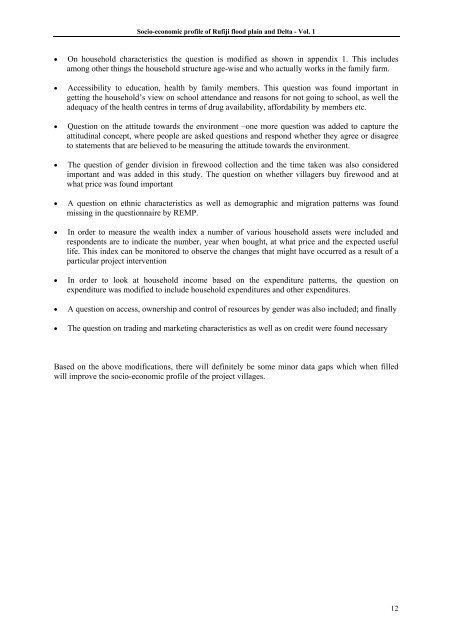A Socio-Economic Profile of the Rufiji Floodplain and Delta.
A Socio-Economic Profile of the Rufiji Floodplain and Delta.
A Socio-Economic Profile of the Rufiji Floodplain and Delta.
Create successful ePaper yourself
Turn your PDF publications into a flip-book with our unique Google optimized e-Paper software.
<strong>Socio</strong>-economic pr<strong>of</strong>ile <strong>of</strong> <strong>Rufiji</strong> flood plain <strong>and</strong> <strong>Delta</strong> - Vol. 1<br />
• On household characteristics <strong>the</strong> question is modified as shown in appendix 1. This includes<br />
among o<strong>the</strong>r things <strong>the</strong> household structure age-wise <strong>and</strong> who actually works in <strong>the</strong> family farm.<br />
• Accessibility to education, health by family members. This question was found important in<br />
getting <strong>the</strong> household’s view on school attendance <strong>and</strong> reasons for not going to school, as well <strong>the</strong><br />
adequacy <strong>of</strong> <strong>the</strong> health centres in terms <strong>of</strong> drug availability, affordability by members etc.<br />
• Question on <strong>the</strong> attitude towards <strong>the</strong> environment –one more question was added to capture <strong>the</strong><br />
attitudinal concept, where people are asked questions <strong>and</strong> respond whe<strong>the</strong>r <strong>the</strong>y agree or disagree<br />
to statements that are believed to be measuring <strong>the</strong> attitude towards <strong>the</strong> environment.<br />
• The question <strong>of</strong> gender division in firewood collection <strong>and</strong> <strong>the</strong> time taken was also considered<br />
important <strong>and</strong> was added in this study. The question on whe<strong>the</strong>r villagers buy firewood <strong>and</strong> at<br />
what price was found important<br />
• A question on ethnic characteristics as well as demographic <strong>and</strong> migration patterns was found<br />
missing in <strong>the</strong> questionnaire by REMP.<br />
• In order to measure <strong>the</strong> wealth index a number <strong>of</strong> various household assets were included <strong>and</strong><br />
respondents are to indicate <strong>the</strong> number, year when bought, at what price <strong>and</strong> <strong>the</strong> expected useful<br />
life. This index can be monitored to observe <strong>the</strong> changes that might have occurred as a result <strong>of</strong> a<br />
particular project intervention<br />
• In order to look at household income based on <strong>the</strong> expenditure patterns, <strong>the</strong> question on<br />
expenditure was modified to include household expenditures <strong>and</strong> o<strong>the</strong>r expenditures.<br />
• A question on access, ownership <strong>and</strong> control <strong>of</strong> resources by gender was also included; <strong>and</strong> finally<br />
• The question on trading <strong>and</strong> marketing characteristics as well as on credit were found necessary<br />
Based on <strong>the</strong> above modifications, <strong>the</strong>re will definitely be some minor data gaps which when filled<br />
will improve <strong>the</strong> socio-economic pr<strong>of</strong>ile <strong>of</strong> <strong>the</strong> project villages.<br />
12
















